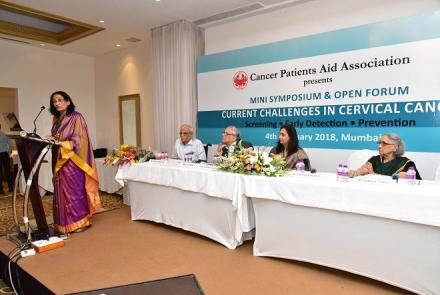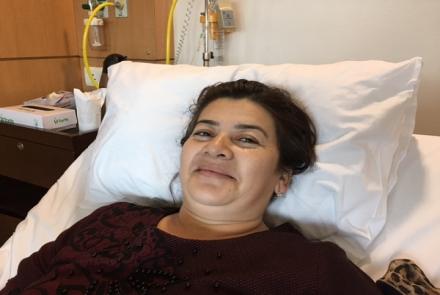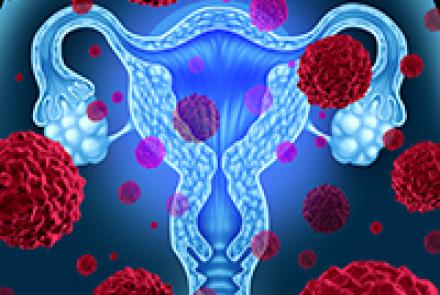
There are many tests that may be done to detect and confirm Cervical Cancer
Medical history and physical exam:
First, the doctor will ask you about your personal and family medical history. This includes information related to risk factors of cervical cancer and symptoms of cervical cancer. He or she will do a complete physical exam. The doctor will do a pelvic exam and may do a Pap test if one has not already been done. In addition, your lymph nodes will be checked closely for evidence of metastasis (cancer spread).
The Pap test is a screening test, not a diagnostic test. An abnormal Pap test result may mean more testing, sometimes including tests to see if a cancer or a pre-cancer is actually present.
If your Pap test is abnormal, you may have to get the following tests done.
Colposcopy: The colposcope is an instrument with a magnifying lense that lets the doctor see the surface of the cervix clearly. The doctor will apply a weak solution of acetic acid (similar to vinegar) to your cervix to make any abnormal areas easier to see. This is done in the doctor’s office.
If an abnormal area is seen on the cervix, a biopsy will be done.
Cervical biopsies: In a biopsy, a small piece of tissue is removed from the area that looks abnormal. The sample is sent to a pathologist to be examined under a microscope. A biopsy is the only way to tell for certain whether an abnormal area is a pre-cancer, a true cancer, or neither. The cervical biopsy can cause discomfort, cramping, or even pain in some women. There are different types of biopsies to diagnose cervical pre-cancers and cancers. If the biopsy can completely remove all of the abnormal tissue, it might be the only treatment needed.
Colposcopic biopsy: For this type of biopsy, first, the cervix is examined with a colposcope to find the abnormal areas. Using a biopsy forceps, a small section of the abnormal area on the surface of the cervix is removed. The biopsy procedure may cause mild cramping, brief pain, and some slight bleeding afterward. A local anaesthetic is sometimes used to numb the cervix before the biopsy.
Endocervical curettage (endocervical scraping): Sometimes the transformation zone (the area at risk for HPV infection and pre-cancer) cannot be seen with the colposcope. In that casethe doctor takes a scraping of the endocervix by inserting a narrow instrument (called a curette) into the endocervical canal (the part of the cervix closest to the uterus). The curette is used to scrape the inside of the canal to remove some of the tissue, which is then sent to the laboratory for examination. After this procedure, patients may feel a cramping pain, and they may also have some light bleeding.
Cone biopsy: In this procedure, also known as conization, the doctor removes a cone-shaped piece of tissue from the cervix. The base of the cone is formed by the ectocervix (near the vagina), and the point or apex of the cone is from the endocervical canal. The transformation zone (the border between the ectocervix and endocervix) is the area of the cervix where pre-cancers and cancers are most likely to start, and is contained within the cone specimen. The cone biopsy can also be used as a treatment to completely remove many pre-cancers and some very early cancers. Having had a cone biopsy will not prevent most women from getting pregnant, but if a large amount of tissue has been removed, women may have a higher risk of giving birth prematurely.
Diagnostic confirmative tests for women with cervical cancer
If a biopsy shows that cancer is present, your doctor may order certain tests to see how far the cancer has spread. Many of the tests described below are not necessary for every patient. Decisions about using these tests are based on the results of the physical exam and biopsy.
Cystoscopy, proctoscopy, and examination under anaesthesia
These are most often done in women who have large tumours. They are not necessary if the cancer is caught early.
Cystoscopy lets the doctor check your bladder and urethra to see if cancer is growing into these areas with the help of a slender tube. Biopsy samples can be removed during cystoscopy for pathologic (microscopic) testing. Cystoscopy can be done under a local anesthetic, but some patients may need general anaesthesia. Your doctor will let you know what to expect before and after the procedure.
Proctoscopy is a visual inspection of the rectum through a lighted tube to check for spread of cervical cancer into your rectum.
Pelvic exam under anesthesia: Your doctor may also do this to find out if the cancer has spread beyond the cervix.
Imaging studies: Imaging studies, such as magnetic resonance imaging (MRI) and computed tomography (CT) scans show whether the cancer has spread beyond the cervix.
Chest x-ray: Your chest may be x-rayed to see if cancer has spread to your lungs. This is very unlikely unless the cancer is far advanced.
CT scan is an x-ray procedure that produces detailed cross-sectional images of your body. CT scans can help tell if your cancer has spread to the lymph nodes in the abdomen and pelvis. They can also be used to see if the cancer has spread to the liver, lungs, or elsewhere in the body. CT scans are sometimes used to guide a biopsy needle precisely into an area of suspected cancer spread. This procedure is called a CT-guided needle biopsy.
MRI scans use radio waves and strong magnets instead of x-rays to take pictures. Not only does this produce cross-sectional slices of the body like a CT scanner, it can also produce slices that are parallel with the length of your body.
MRI images are particularly useful in examining pelvic tumors. They are also helpful in detecting cancer that has spread to the brain or spinal cord.
MRI scans take longer than CT scans - often up to an hour.
Intravenous urography is rarely used nowadays. Also known as intravenous pyelogram, or IVP, it is an x-ray of the urinary system taken after a special dye is injected into a vein. This test finds abnormalities in the urinary tract, such as changes caused by spread of cervical cancer to the pelvic lymph nodes, which may compress or block a ureter. You will not usually need an IVP if you have already had a CT or MRI.
Positron emission tomography (PET) scan is rarely used for patients with early cervical cancer, but may be used to look for more advanced disease. PET scan uses glucose (a form of sugar) that contains a radioactive atom. Cancer cells in the body absorb large amounts of the radioactive sugar and a special camera can detect the radioactivity. This test can help see if the cancer has spread to lymph nodes. PET scans can also be useful if your doctor thinks the cancer has spread but doesn’t know where. PET scans can be used instead of other types of x-rays because they scan your whole body. Some machines combine a CT scan and a PET scan to even better pinpoint the tumour.

















